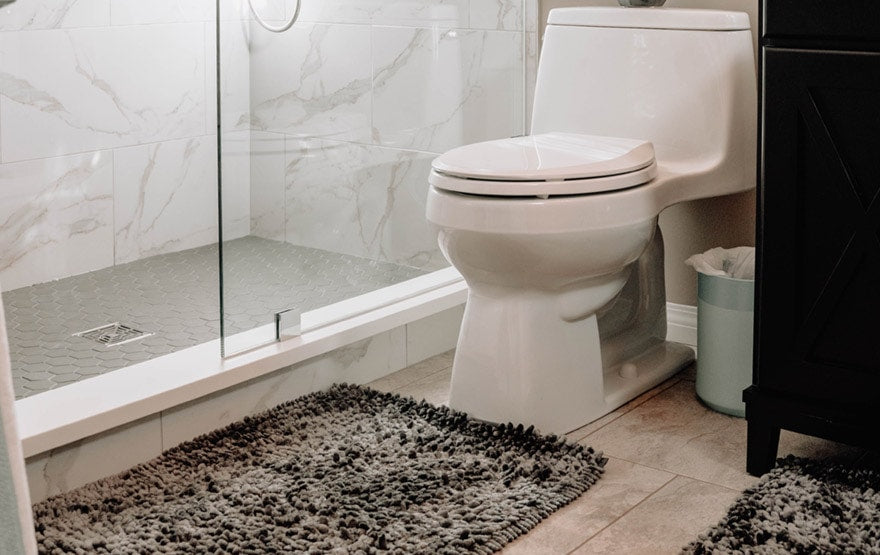Your Cart is Empty
Injury

Whether your physical capabilities are changing due to age, illness, injury or surgery recovery, bathroom safety should be a priority. Due to slick surfaces and the high risk of falling in and around the toilet, the bathroom is considered the most dangerous room in the house. Fortunately, there are ways to reduce the risk of falls and make the navigating the bathroom independently safer for either you or a loved one. Keep scrolling to learn what dangers to look for and the safety precautions you can implement.
The shower and bathtub are particularly high traffic areas that can pose a health risk, no matter the state of your health. They are an essential part of personal hygiene often associated with wet slippery surfaces, thus finding and implementing safety solutions is crucial.
Traditional bathtub and shower combinations have a high edge to step over and clear every time you need to get in and out. This requires good single leg balance and leg flexibility and strength to consistently stay safe with this movement. Otherwise, you will find yourself unable to safely enter and exit. Being able to maneuver well is important for maintaining independence and confidence while keeping good personal hygiene. Here are some recommended solutions to help make getting in and out of the shower or tub easier.
Getting in and out of the tub isn't easy; it takes balance, coordination and strength. Installing a bath rail to the side of your tub will give you support and leverage to more easily enter and exit the tub, as well as sit down and stand up. It's a small investment that can make a big difference when it comes to safety.
A lack range of motion or strength in your lower body can turn stepping in or out of a tub into an unsafe situation. A transfer bench allows you to sit down and then scoot into your showering or bathing area. Most have handles to help you keep balanced as you sit down, scoot in and out, stand back up, plus provide the option to sit while showering. All great for minimizing the risk of injury.
If you have decent strength and balance, but just need a little boost to step in and out for safety, consider a bath step. This 4 inch steps gives you that little extra height you need when you don’t have the flexibility in your knee, hips, and/or ankles to clear the edge. Combine it with use of a bathroom rail for maximize comfort and safety.

For those who have limited balance, mobility and/or strength, showering while standing increases the risk of injuries. Slip and falls can occur unexpectedly with simple maneuvers while washing or fatigue upon standing; often resulting in serious injuries or even hospitalization. While the risk of slips and falls in the shower or bath is high, fortunately there are some things you can do to help minimize the dangers.
When it comes to the hard and slippery surfaces, the best bet is to create some traction. Installing a non slip bath or shower mat not only decreases the risk of slipping, some provide a thin layer of cushioning under your feet to help reduce fatigue. However, avoid thick mats since this can inadvertently cause an unwanted tripping hazard.
Non-slip stickers can be easily installed on the floor of your shower or tub by adhesive material. Place the stickers close enough together so that neither of your feet are completely touching the sleek surface of the tub.
Grab bars are a great substitution for artificial supports like towel racks or glass doors; which aren't designed to bear weight. A suction cup grab bar is good for temporary or travel use, but those who need more, long-term, support should opt for a metal grab bar that can be securely drilled into the wall. When installing a permanent bar, make sure you consider the optimal place for safety and ease of use in your specific bathroom layout. Ask yourself these questions:
If you're recovering from surgery, fatigue more easily from standing, or are unable to bend down or balance in the shower, using a shower chair or stool will provide the support you need. A shower chair is a sturdier option that provides armrests for more stability and ease of use, but a stool is more versatile since it is smaller and fits in most showers and tubs.
Need Help Choosing the Right Shower Chair?
Getting those hard to reach places in a traditional shower can lead to unsafe twisting and reaching motions that compromise balance. Additionally, you put yourself at risk for injuring yourself, particularly your spine, from attempting poor mechanics. Having an adjustable shower head can help you with any awkward places without having to contort yourself into unnecessary positions. It's also convenient if you plan to use a shower chair.
Areas of the body that notoriously collect sweat and dirt are also typically areas that are hard to reach, such as the back, feet, and armpits. Eliminate bending and twisting all together and avoid injury due to slipping or tweaking your body, by using a long handled sponge or loofah.
A foot scrubber is another great tool that attaches to the shower or tub floor with suction cups. It eliminates having to bend down or balance on one foot to clean your feet.
A shower caddy can keep all bathing essentials is a centralized area of the bath that’s easy to reach and will minimize having to overreach, twist or turn in different directions to retrieve what you need. This will also help reduce the risk of bottles and soap bars falling unexpectedly from ledges. Installing a wall soap, shampoo & conditioner dispenser is also another great idea.

Using the toilet becomes increasingly difficult with decreased energy, coordination, and strength, but performing this task is essential for maintaining independence and good hygiene at home. Some of the most difficult challenges faced in the bathroom involve getting on and off the toilet and actually getting to the restroom on time in a safely manner. Here are some things that can help.
Being able to get on and off the toilet safety is crucial for self-care. If you are unable to control your ascent and/or descent onto the toilet, you risk straining your body, falling off the toilet, or even getting stuck. Check out the recommendations below to make toilet transfers easier at home:
Adding upper arm strength to the transfer equation via grab bars can make the toileting process much easier. When installing them in your bathroom, consider your to optimize placement. For example, try to place it so that you can use your stronger side. Also, minimize the need for reaching and straining if possible.
A higher toilet seat decreases the joint range of motion and overall strength you need to navigate the toilet. After surgery, these seats are often recommended for use by doctors. There are a few different styles of raised toilet seats. Some come with arms and some are just the seat with added height. Consider your personal needs to make the best decision, you also don't want the seat to be too high, as this poses a risk for slipping forward off the seat.
Toilet safety rails offer a lot more stability with toilet transfers. Plus, they improve mechanics and boost available strength by utilizing the use of both your arms to sit and stand from the toilet. These are easily installed and fit in most bathrooms. What option is best for you depends on whether you also want a raised seat, your body weight, and what your bathroom can accommodate.
Check Out Our Raised Toilet Seat & Safety Rail Guide for More Information
Another big concern for toileting involves the process of actually getting to the bathroom due to limited mobility and/or urgency issues. If you're injured, recovering from surgery, or require assistance to get out of bed, set yourself up for success.

While the toilet and shower or tub are the most common places of injury, there are several other bathroom hazards you should take into consideration. Check out these commonly overlooked situations and evaluate your space to minimize risk.
Being able to see where you are going is an essential part of safely getting around your home. Walking in dim or dark lighting significantly compromises balance. Adequate lighting (especially at night) is not only important in the bathroom but also along the route you take to get there. Here are some tips:
Bathrooms are notorious for slippery surfaces due to slick tile floors, tub and shower surfaces. Built up water, mold, dirt, or product are typically the main culprits. To avoid slippery floors, try these tips:
Removing tripping hazards is essential for decreasing fall risk. This means getting rid of risky items such as throw rugs and general clutter in addition to being extra aware of any pets you may have. Solutions include towel hooks for hanging things, purging unnecessary items around the home, and safely organizing items into bins, shelves, closets, and drawers.
Clean out medicine cabinets and organize daily medications into pill organizers to reduce bottles.
Towel racks are a great way to reduce clutter in your bathroom. However, they can be a hazard when used for anything other than hanging or organization. They are not made to support weight, like a bathroom handle or rail. Remove any towel racks in areas of the bathroom that you are tempted to reach for. This will prevent unnecessary safety hazards from loss of balance or even a fall.
Opening and shutting doors can lead to loss of balance or cause injury. Take extra care with maneuvering doorways, especially with glass door panels that may break.
Additionally, doors that swing into the bathroom to open can be hazardous. If you or a loved one do fall, the person may unintentionally block the entrance into the bathroom. Making it nearly impossible for someone to get in to help.
If your skin sensation is compromised, you are at risk of burning yourself with hot water when using the sink or shower. Consider getting a temperature gauge or having someone assist you with water use.
If minor additions or changes just aren’t enough or the issues you are having are more chronic, here are some bigger options for your home. Renovations can sometimes be funded by grants, volunteer programs, or insurance. Discuss your options with your family, a social worker, or other community members to determine the best possible option for you.
Consider adjusting your home so that everything you need is on the first floor. This will minimize fatigue and allow you to avoid the use of stairs. This may involve adjusting or moving bedrooms, bathrooms, and a laundry room to the first floor.
If you simply don’t have the strength, even with modification, to get on or off the toilet, in and out of bed, or in and out of the tub with bathing, you may need to have a lift installed. Lifts can be electric or mechanical and come in many sizes to accommodate different body types. There are both movable versatile options and stationary options. Talk to a medical equipment specialist to choose what’s right for you. These are not recommended for independent use and will require the help of a caregiver.
A walk-in shower can minimize the energy and lower body flexibility needed to enter. You can choose to install a built-in shower bench with the shower, otherwise, you will probably still want a stand-alone shower or transfer bench.
Some homes are simply not designed with adaptive equipment in mind. Widening hallways, doorways, and room size may be necessary to accommodate any equipment you need for safe mobility and functioning at home.
Other options for increasing wheelchair accessibility include:
When bathing or showering, be sure to protect any healing wounds, bandages, or surgical scars that you may have. Cast covers are reusable, act as a waterproof barrier to keep area dry, and allow you to keep up with your hygienic needs without compromising the integrity of bandages or casts. They will also help to prevent infection while protecting the covered area.
If renovations are just too big to take on, consider moving to a more manageable home. This might mean moving into a smaller home, one with larger or more equipped bathrooms, moving in with family, or going somewhere that provides assistance as you find you need it. Ultimately, choose the option that you are most comfortable and happy with while staying safe.

Whether it is a friend, family member, or hired care, if you’re struggling with home care and feel unsafe, consider asking for help. For higher risk activities, consider scheduling time to have someone available for showering and personal hygiene. They can also help you stay on top of your home’s cleanliness to reduce clutter and other fall risks. The person doesn’t necessarily have to be standing next to you and watch you shower the entire time (unless your doctor recommends it). Just make sure that someone is in the house and within vocal distance to assist you if you do fall. If someone will be home with you, you can also consider getting a wireless call button.
If your risk for falling is due to health or medical changes, consult with your doctor about rehabilitation services such as physical and occupational therapy. Make endurance and strength your goals for rehabilitation so that you can perform showering/bathing tasks on your own with less fatigue.
When it comes to maintaining your safety at home, the range of options is pretty wide. Ultimately, find what fits your specific impairments, budget, and keeps you safe. It’s important to remember that not all accidents are preventable, unexpected medical episodes can happen with no warning. Heart attacks, stroke, changes in blood sugar levels, and respiratory distress can increase the risk of injury at any moment. However, you can significantly decrease your risk of health issues by taking necessary safety precautions.
BATHROOM SAFETY PRODUCTS![The Benefits of Flexibility [A.K.A. The Secret Sauce for Aging]](http://www.vivehealth.com/cdn/shop/articles/Smiling-retired-woman-listening-to-music-while-stretching-legs-outdoors._600x.jpg?v=1713090677)


